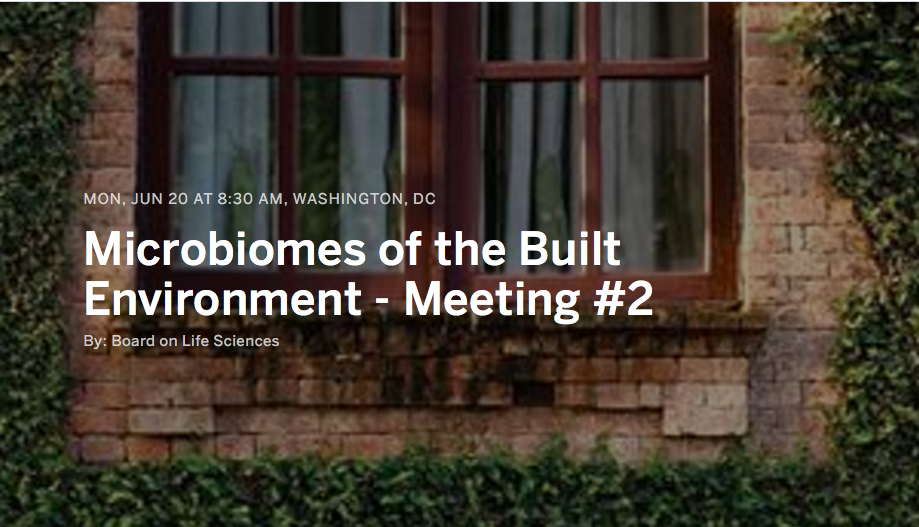Coming next week June 20-21 Meeting #2 of the NAS study on Microbiomes of the Built Environment. Meeting is free to attend in person or online and the agenda includes some amazing people so it should be worth checking out.
Some more detail from their website is below:
The study’s second public meeting will be held on June 20-21, 2016 at the 20 F Street Conference Center in Washington, DC (20 F Street NW, Washington DC 20001). The meeting will focus on Understanding Microbial Communities in Built Environments and will focus on issues surrounding the following questions:
- What are the primary variables affecting composition and diversity of built environment microorganisms?
- What interactions occur between built environment microbiomes and human occupants?
- How will the public interact with the information that results from built environment microbiome studies, and what are lessons learned from risk assessment communication that can assist in better informing the public?
- What are the major building systems that will affect or be affected by indoor built microbiomes, how should they be characterized, and what is their impact on the indoor built microbiome?
Please click here to view the final meeting agenda (also copied below)
Please click here to register to attend the meeting in person or via webcast (accessing the webcast is free and open to all participants). If you have any questions please email builtmicrobiome@nas.edu.
Agenda:
Microbiomes of the Built Environment: From Research to Application: Meeting 2 Understanding Microbial Communities in Built Environments
20 F Street Conference Center
20 F Street NW, Washington DC 20001 June 20-21, 2016
Monday, June 20
Light breakfast will be available
8:45am Welcome and Introductions
- Joan Bennett, Committee Chair
- Committee member introductions (name and affiliation) Goals of the study and open sessions
9:00 Opening Session: Perspectives on Microbial Interactions in Built Environments
- Jo Handelsman, Office of Science and Technology Policy (invited)
- Brent Stephens, Illinois Institute of Technology
- Discussion
10:15 Break
10:30 Public Engagement on the Implications of Built Environment Microbiomes
- How will the public engage in understanding built environment microbiomes and interact with the information that results from such studies?
- How is the public likely to respond to the implications, and can any lessons be derived from experiences with citizen science and risk assessment communication?
- Lee Ann Kahlor, University of Texas at Austin
- Rob Dunn, North Carolina State University (remote) – Discussion
11:45 Lunch
1:00 Linking Human Occupants and Built Environment Microbiomes
What interactions occur between built environment microbiomes and human occupants, including human microbiomes? What are the consequences of these interactions?
- Jack Gilbert, University of Chicago
- Elizabeth Grice, University of Pennsylvania
- Susan Lynch, University of California, San Francisco
- Gary Adamkiewicz, Harvard School of Public Health
- Donald Milton, University of Maryland (remote)
- Chuck Haas, Drexel University
- Joanne Sordillo, Brigham and Women’s Hospital and Harvard T.H. Chan School of Public Health
- Discussion
3:30 Break
3:45 Parallel Breakout Discussions:
- What do we really need to know about built environment microbiomes in order to move toward application?
- Identify key questions that would need to be answered to understand the functions of microbiomes in built environments.
- What information would need to be obtained in order to move from basic microbiome research and characterization to application in building design and operation?
5:15 Reconvene in Plenary – Recap of Day 1 and Preliminary Key Points Raised in Breakouts
5:30 Adjourn Day 1
Tuesday, June 21
Light breakfast will be available
8:30 Welcome and Goals for Day 2
8:45 Reporting from Breakouts
- What questions does the field need to answer and what are the most critical types of information that need to be collected to answer these questions? (1 rapporteur per group)
- GroupA
- GroupB
- GroupC
- Discussion
9:45 Break
10:00 Building Systems: Impacts and Characterization
- What do we know about various building systems, their relevant features, and links between building science and indoor microbial environments?
- Andrew Persily, NIST
- Terry Brennan, Camroden Associates
- Dennis Stanke, Trane Ingersoll Rand (retired)
- Jeffrey Siegel, University of Toronto
12:15 Concluding Remarks
12:30 Public Meeting Adjourns

